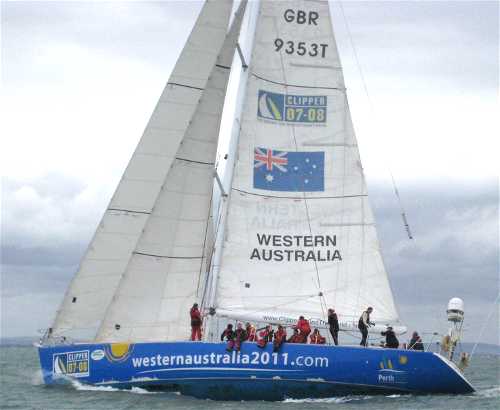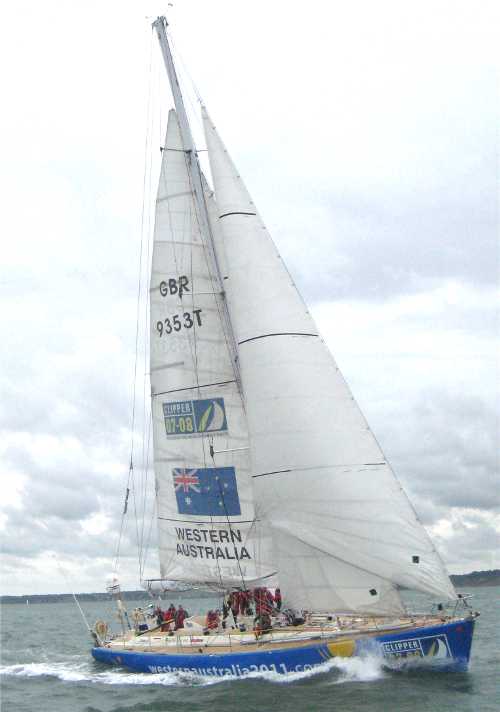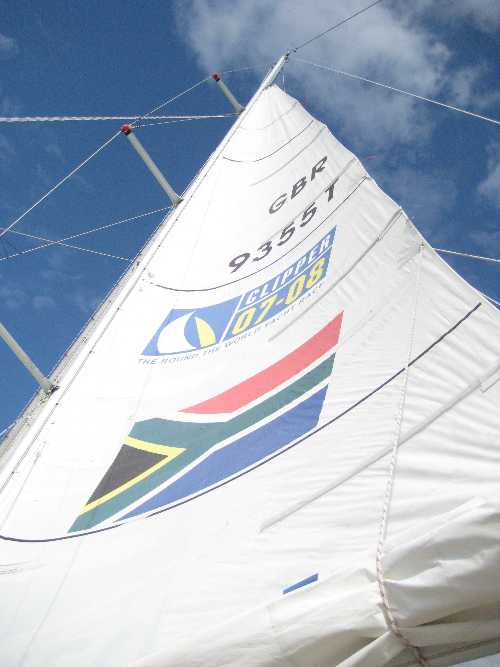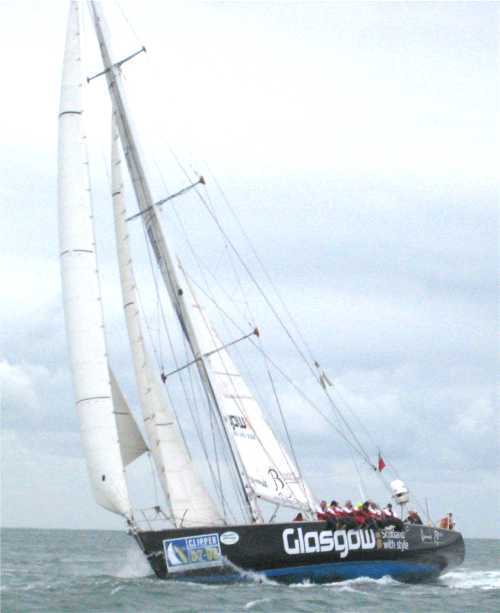Clipper 60 Ocean racing with sails !
This page is about my opinions about the sails used on these Clipper 60 boats. I don't expect you all to agree.

Western Australia: Came 1st.
Jib: Looks good, maybe slightly flat, possibly steering closer to the wind the moment the picture was taken.
Somehow that have managed to get it far better then Glasgow - see below. The forestay and staysail luff are really tight.
Staysail: Fine.
Main: Fine. Nice curve and boom is well out. Forward half of upper main is pulling well.

Western Australia: Came 1st.
Jib: Looking good. Slightly curled in leech in the upper half.
How do you get the maximum depth of the curve a bit further forwards?
The forestay is really tight.
Staysail: Fine.
Main: Fine. Nice curve and upper part doing useful job.

Durban. Came 2nd.
Main: Good shape, outhaul not too tight as in Glasgow below. Need to take care that rear third of sail remains outboard of parallel with the hull.

Glasgow came a long way behind .... 3rd.
Jib: Excess curve and twisted too much. Maybe it simply needs pulling it in much tighter. While sailing to windward we followed a compass course slightly off the wind compared with Western Australia but we were still too close to the wind to get the flow right on our jib which was frequently back winded. This annoyed me and I felt we should turn further away from the wind, but the objective was to steer a course. Now I've seen these pictures I can see what was the problem. The forestay is much less tight than on Western Australia. Put a straight edge up against the photo; there is 3mm gap. We should have tightened the backstay or pulled down with the mainsheet perhaps ? What is the correct tension and how do you set it up ?
Staysail: The leading edge is hopelessly curved. Would be nice if the clew could come down just a little to narrow the slot higher up.
Main: Tight leech and minimal twist due to tight vang. It would be interesting to have done some mast bend photos. My impression from the above is that we had far more mast bend than Durban or Western Australia. The foot outhaul is rather tight with little curve in the sail, but even so care needs to be taken that the rear third of the sail is a few degrees or so off the centre line, so the rear of the sail is not pulling us backwards. Maybe it would have been better to move the mainsheet traveller out a bit and get more down force to pull the mast head back. Easing the vang would have reduced mast bend, increased sail depth, increased twist spilling some wind, and reduced stress on the mast, maybe allowing the backstay to be tightened without over stressing the mast.
Ideas for next time: Discuss all this kind of thing during the pre-race get together to make sure we don't have fundamental differences of opinion about how to sail the boat (e.g. when going to windward, steering a course compared with steering to the wind) and to agree how the sails will be trimmed and how advice from multiple crew members will be aggregated and applied. During off-wind, course sailing, should sail trim be delegated so that 3 pairs of people can independently keep adjusting jib, staysail and main according to what they see ? When on the wind should someone up on the bow direct the steering ? We need design data about set up tensions and instruction on how to set them up without avoid overstressing anything. Get more (and not worn out) tell-tails added to the sails. Take pictures up the forestay, up the staysail luff and up the mast every hour. Adjust backstay(s) and mainsheet to get correct forestay and staysail luff tension. We need a better understanding of the running backstays, one of which could have been used to alter the staysail luff tension. Adjust the mast bend with vang and running backstays to get correct mast bend. We need design data about set up tensions and instruction on how to set them up while avoiding overstressing anything.
Take pictures up the middle of all three sails and measure actual clew positions and record which slider eye positions are in use. Get someone to navigate and record position and progress every half hour. Record and review sail trim every half hour and apply changes systematically based on measurements. Some kind of graph of speed versus time would help identify quickly if changes are of benefit of not.
The next race is due 24th - 26th October 2008 with the race course dependent on wind.
Options include:- Cross Channel, Weymouth , Plymouth, Round the Island.
The comments above are just a few of my thoughts. I know everyone has different views and opinion on this so please, if you agree or disagree, please say. I've got my own strange ideas about how sails work. If you want to read about this, follow the link at the top of this page!
Write me some text to add under each pictures and send me an email eric@satsig.net
|
Page started 27 Aug 2008, amended 9 Jun 2021. eric@satsig.net The four images above are Copyright (c) 2008 Robert Shearwood, and used here with permission. |